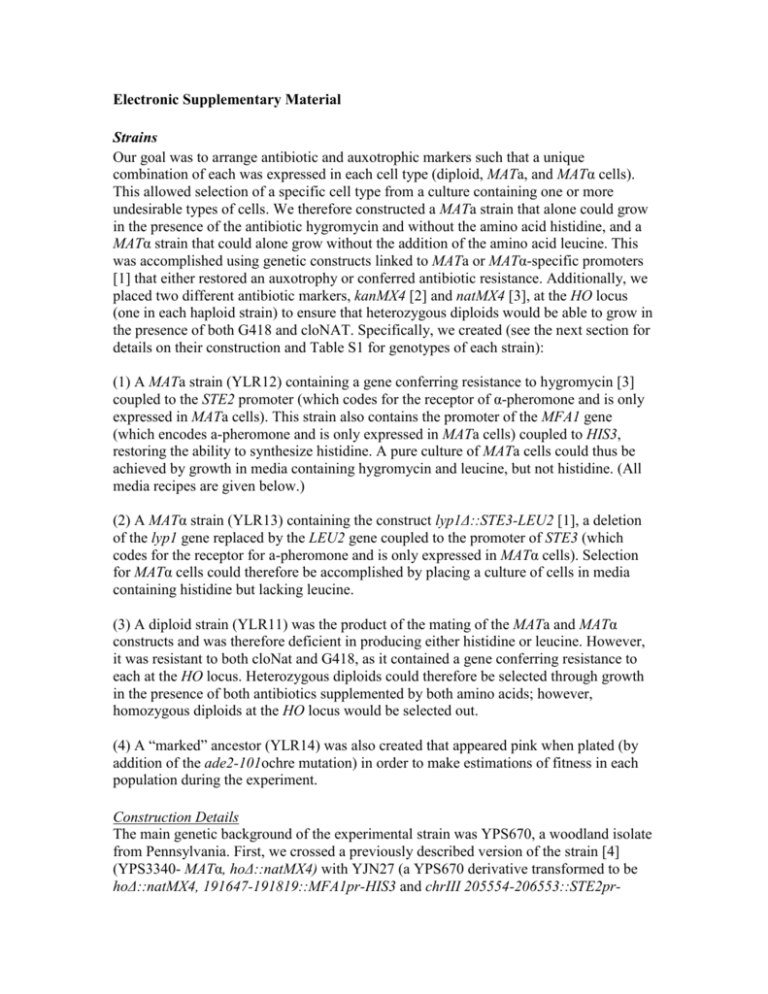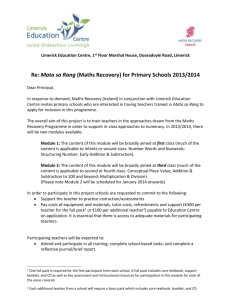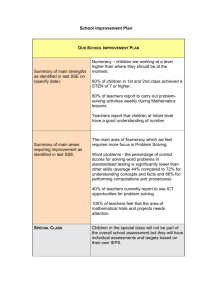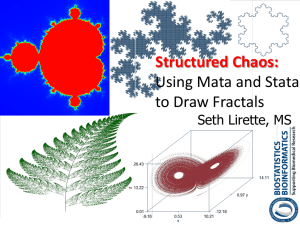Electronic Supplementary Material
advertisement

Electronic Supplementary Material Strains Our goal was to arrange antibiotic and auxotrophic markers such that a unique combination of each was expressed in each cell type (diploid, MATa, and MATα cells). This allowed selection of a specific cell type from a culture containing one or more undesirable types of cells. We therefore constructed a MATa strain that alone could grow in the presence of the antibiotic hygromycin and without the amino acid histidine, and a MATα strain that could alone grow without the addition of the amino acid leucine. This was accomplished using genetic constructs linked to MATa or MATα-specific promoters [1] that either restored an auxotrophy or conferred antibiotic resistance. Additionally, we placed two different antibiotic markers, kanMX4 [2] and natMX4 [3], at the HO locus (one in each haploid strain) to ensure that heterozygous diploids would be able to grow in the presence of both G418 and cloNAT. Specifically, we created (see the next section for details on their construction and Table S1 for genotypes of each strain): (1) A MATa strain (YLR12) containing a gene conferring resistance to hygromycin [3] coupled to the STE2 promoter (which codes for the receptor of α-pheromone and is only expressed in MATa cells). This strain also contains the promoter of the MFA1 gene (which encodes a-pheromone and is only expressed in MATa cells) coupled to HIS3, restoring the ability to synthesize histidine. A pure culture of MATa cells could thus be achieved by growth in media containing hygromycin and leucine, but not histidine. (All media recipes are given below.) (2) A MATα strain (YLR13) containing the construct lyp1Δ::STE3-LEU2 [1], a deletion of the lyp1 gene replaced by the LEU2 gene coupled to the promoter of STE3 (which codes for the receptor for a-pheromone and is only expressed in MATα cells). Selection for MATα cells could therefore be accomplished by placing a culture of cells in media containing histidine but lacking leucine. (3) A diploid strain (YLR11) was the product of the mating of the MATa and MATα constructs and was therefore deficient in producing either histidine or leucine. However, it was resistant to both cloNat and G418, as it contained a gene conferring resistance to each at the HO locus. Heterozygous diploids could therefore be selected through growth in the presence of both antibiotics supplemented by both amino acids; however, homozygous diploids at the HO locus would be selected out. (4) A “marked” ancestor (YLR14) was also created that appeared pink when plated (by addition of the ade2-101ochre mutation) in order to make estimations of fitness in each population during the experiment. Construction Details The main genetic background of the experimental strain was YPS670, a woodland isolate from Pennsylvania. First, we crossed a previously described version of the strain [4] (YPS3340- MATα, hoΔ::natMX4) with YJN27 (a YPS670 derivative transformed to be hoΔ::natMX4, 191647-191819::MFA1pr-HIS3 and chrIII 205554-206553::STE2pr- hphMX4, generously provided by JN Jasmin, Wake Forest University). Both of these regions on chromosome III are intergenic; the MFA1 promoter contains 394bp upstream from the start codon and the STE2 promoter contains 557bp. From this cross, we isolated a strain that was MATa, chrIII 191647-181819::MFA1pr-HIS3, chrIII 205554206553::STE2pr-hphMX4, hoΔ::natMX4 and contained the rest of the YPS670 background. Next, we crossed this strain with BY8205 (MATα, can1Δ::STE2pr-Sp_his5, lyp1Δ::STE3pr-LEU2, leu2Δ, his3Δ, ura3Δ, derived from S288c, gift of Charles Boone, University of Toronto), to incorporate leu2Δ, his3Δ, and lyp1Δ::STE3pr-LEU2. Through numerous backcrosses, all other auxotrophies associated with the lab strain were selected out. Finally, we crossed the MATα strain with YPS3062 (MATa, hoΔ::kanMX4, YPS670 derivative) to switch the antibiotic marker at the HO locus. We estimate that the final strain was 85% YPS670 and 15% S288c. Finally, a marked ancestor was created by crossing the ancestral strain to YMZ336, a YPS670 derivative with an adenine auxotrophy (ade-101ochre). Media Evolution Medium-Diploids 0.1% dextrose, 0.17% yeast nitrogen base, 0.1% glutamic acid, 0.2M NaCl, 250 mg/L histidine, 250 mg/L leucine, 375mg/L G418, and 250 mg/L cloNat. To improve the effectiveness of the antibiotics, glutamic acid was substituted for ammonium sulfate (http://mgm.duke.edu/faculty/mccusker/lab/resources/). Histidine and leucine were added, as diploids cannot endogenously produce either of these amino acids. The presence of G418 and cloNat was necessary to ensure populations of pure diploid cells, but also removed all diploids homozygous at the HO locus for either kanMX4 or natMX4 (see ‘Diploid selection’ in ‘Experimental Cycle’ below). This should not bias our results, as these alleles segregate at random during meiosis. For the fitness assays, this medium was supplemented with 100 mg/L adenine, more than 5 times the amount found in typical medium. Evolution Medium- MATa selection 0.1% dextrose, 0.17% yeast nitrogen base, 0.1% glutamic acid, 0.2M NaCl, 250 mg/L leucine, and 400 mg/L Hygromycin. This concentration of leucine is roughly 10 times the concentration in typical media and used in our experiment in order to minimize selection for autotrophic cells at this stage of the experimental cycle. Only MATa cells express resistance to Hygromycin and produce histidine endogenously. Evolution Medium- MATα selection 0.1% dextrose, 0.17% yeast nitrogen base, 0.1% glutamic acid, 0.2M NaCl, and 250 mg/L histidine. Only MATα cells produce leucine endogenously. Unlike MATa cells, histidine must be added to media to allow growth. The selective environment for both types of haploids therefore closely paralleled that of the diploids, with small changes in media composition to allow selection for the two types of haploids. Sporulation Medium 1% potassium acetate, 250 mg/L histidine, 250 mg/L leucine, and 1.5% agar. Addition of histidine and leucine were necessary because diploids cannot produce histidine and leucine endogenously. These concentrations of amino acids are 5-10 times that in typical media to ensure minimal selection during this phase of the experimental cycle. Mating Medium 0.1% dextrose, 0.17% yeast nitrogen base, 0.1% glutamic acid, 0.2M NaCl, 250 mg/L histidine, 250 mg/L leucine, 1.5% agar. The medium was sterilized and poured into the wells of a 24-well plate and allowed to cool to create a solid surface for mating. After mating occurred, liquid evolution medium supplemented with antibiotics (see above) was added to the wells and pipetted up and down to suspend cells. Alternate Medium- Sucrose-based 0.1% sucrose, 0.17% yeast nitrogen base, 0.1% glutamic acid, 0.2M NaCl, 250 mg/L histidine, 250 mg/L leucine, 375mg/L G418, and 250 mg/L cloNat. Experimental Cycle A single diploid colony was used to found all populations to begin the experiment. The colony was grown in evolution medium supplemented with antibiotics (see “Evolution Medium-Diploids” above) for 24h at 30°C in a standing incubator. Serial transfers. To begin the experiment, 12 wells of a 24-well plate each containing 2mL of EM supplemented with antibiotics were inoculated with 20µL of culture (from the single diploid colony). After 24h of asexual growth in a 30°C standing incubator, 20μL of each population were transferred to a new 24-well plate containing fresh medium and incubated at 30°C. This was done a total of 3 times during each cycle, representing 4 24-hour periods of diploid growth in a standing incubator. Meiosis. 24h after the final transfer, each population (with the exception of the four asexual populations, which were placed at 4°C until the serial transfer phase) was induced to undergo meiosis (i.e. sporulation). Populations were washed, resuspended in 50μL water, transferred to a small sporulation plate (which allows for >90% sporulation rate), and incubated at 30°C. Roughly 36h later, sporulation was verified for a subsample of all populations via microscopy. The sporulated cells were resuspended in 1mL water and incubated at 55°C for 45 min to kill all diploid cells [5]. Elimination of diploids was necessary to ensure only cells undergoing meiosis and subsequent sex were passed through to the next cycle. Isolation of pure haploid cultures. Populations were treated with 100μL zymolyase solution (18% sorbitol, 0.01% zymolyase 100T, 5% 2-mercaptoethanol) and rotated for 4 - 4.5h at 30°C. 2μL Triton X was then added to each tube and vortexed on high for at least 5 min to separate spore clumps. Each population was then centrifuged and resuspended in 500μL distilled water. Half of each population was transferred to MATa or MATα selective medium. Mating and sexual selection. After 24h, pure MATa and MATα cultures were obtained. MATa and MATα cells from the same original population were combined in the prescribed ratio by volume. The number of MATa cells was constant across treatment groups; the MATα cells were varied, leading to a larger effective population size in the strong sexual selection treatment than in the weak at this part of the cycle (see ‘Effective Population Size’ below). The mixed culture was centrifuged and resuspended in a small amount (~20μL) of water and placed on a solid mating plate. The populations were then left overnight to mate at 30°C. Diploid selection. The following morning, ~12h after mating, the mated cultures were suspended in the evolution medium supplemented with antibiotics to select for diploids. The serial transfer process began again after 24h. Effective Population Size Serial transfer: The average effective population size for each population during the serial transfer phase was approximately 4 x 106 individuals [6]. The final number of cells after 24h was 1.5 x 107. Sporulation and Haploid Selection: The entire population was induced to sporulate; each diploid cell produces four haploid spores (2 MATa, 2 MATα) on average. Half of each sporulated population, containing haploids of both mating types, were placed in Evolving Medium-MATa selection, the other half in Evolving Medium-MATα selection (see Media above). Half of all haploids (MATa cells in MATα selection medium and MATα cells in MATa selection medium) were eliminated in this process. On average, each diploid cell should be represented by one spore of each mating type in the inoculum of the haploid cultures. This assumes a 100% sporulation efficiency and no loss of spores during the digestion process. We observed a rate of closer to 90% sporulation efficiency and a recovery rate ~80%. The pure haploid cultures reached the same density as the original diploid culture. (As long as sporulation and spore recovery did not decrease the population to 0.01 of its original size, it is not qualitatively different than a round of serial transfer.) Given the sporulation and recovery rate, that each diploid produces on average two haploids of each mating type, and that half the haploids were eliminated, the pure MATa or MATα cultures used in the mating phase contained ~107 individuals of each mating type. Mating: 106 MATa cells were combined with an equal number of MATα cells in the weak selection treatment and 107 MATα cells in the strong selection treatment; in both treatments, on average, 106 diploids should form. Diploid Selection: Only heterozygous diploids were selected for; therefore, the first day of diploid growth started with approximately 5 x 105 diploids and ended with 1.5 x 107 diploids, giving an effective population size of about 2 x 106. Overall, we conservatively estimate the effective population size each complete cycle to be approximately 3.7 x 106 (the harmonic mean of the effective population size of all the days of growth). Note that because the number of MATa cells was held constant while the number of MATα cells was increased to effect our 1:10 mating type ratio, the effective population size of the strong sexual selection populations is roughly 1.8x higher than that of the weak sexual selection populations for the mating component of the cycle. Relative Fitness Assays Cultures of the marked ancestor (YLR14) and evolved strain to be competed were allowed to grow for 48h (24h followed by a 1:100 serial transfer and additional 24h of growth) in glucose media + adenine, as YLR14 carries an adenine auxotrophy. The strains were combined in equal volumes and 10 replicates of this master mix were plated to YPD in a 1:5000 dilution to determine the initial relative abundance of each strain. 20µL of this mix was then added to 10 wells of a 24-well plate containing 2mL glucose media + adenine. After 24h at 30°C, the cultures were transferred in a 1:100 dilution and allowed to grow for an additional 24h. 2 samples from each of the 10 wells were then plated in a 1:5000 dilution to YPD. The number of white (evolved) and pink (marked ancestral) cells were counted on each plate. Raw colony counts are available in the supplementary Excel file. Calculations of relative fitness were based on ref [7]. A Malshusian parameter (m) was determined for each of the 10 samples for each population. This was calculated as: m(A) = ln((# A colonies after 48h competition period x 10,000) / # of initial A colonies) The number of colonies after the 48h competition period was taken as the average of the two samples for a given well, while the initial number of colonies was taken as the average number of colonies from the ten samples of the original master mix. Relative fitness (W) was calculated as the ratio of Malthusian parameters, i.e., W = m(evolved) / m(marked ancestral) Biologically, this term represents that the evolved strain increased at a rate W times that of the ancestral strain. Population Mating Assays Diploids strains to be mated were grown in YPD for 24h at 30°C and sporulated as above. Half of each culture of digested asci from each strain were added to 30mL MATa or MATα selective media and grown for 24h at 30°C. All cultures were then centrifuged at 3000 rpm for 3 min, resuspended in 10mL distilled water, and sonicated for 30s to break up cell clumps. Each culture was centrifuged once again and resuspended in 200μL water. 100μL each of both mating types was mixed thoroughly, plated on a small (35mm diameter) glucose media plate, and allowed to dry in a sterile hood for 30 min. Samples were scraped from plates immediately after drying (hour 0), then 3h thereafter (hour 3). 3 replicates were taken for each sample, diluted 1:1000 and plated to YPD. Although equal volumes of both mating types were mixed together, we controlled for possible deviations from this optimal 50:50 MATa:MATα. Deviations from this ratio result in fewer diploid (mated) yeast, as haploids of one mating type are more plentiful than the other and remain unmated. To determine the exact proportion of MATa:MATα, and thus the theoretically maximum proportion of mated yeast, all hour 0 plates were replica-plated to glucose media plates containing hygromycin, which only allows the growth of MATa haploids. To determine the proportion of mated cells after 3 hours, the hour 3 plates were replicaplated to glucose media plates containing G418 and cloNAT, which only allows for the growth of diploid colonies stemming from cells heterozygous at the HO locus. The proportion of cells mated after 3 hours was calculated as the proportion of heterozygous diploids after 3 hours divided by the maximum proportion of cells that could theoretically mate. This number was then multiplied by two, as on average half of the diploids formed during the mating period were homozygous at the HO locus and thus would not have survived plating on double antibiotic media. By 3 hours, many of the cells have mated. We ended our assay at this time point because observations under the microscope showed mated diploids beginning to bud. Data after this time point would inflate the estimate of mated cells, as it would be biased by growth of diploids (i.e., not indicative of the mating dynamics). Supplementary Tables Table S1: Strains used in this experiment. Strain Name Genotype YLR11 MATa/α, chrIII 191647-181819::MFA1pr-HIS3/chrIII+, chrIII 205554-206553::STE2pr-hphMX4/chrIII+, his3Δ/his3Δ, leu2Δ/leu2Δ, lyp1Δ::STE3pr-LEU2/lyp1Δ::STE3pr-LEU2, hoΔ::natMX/hoΔ::kanMX YLR12 MATa, chrIII 191647-181819::MFA1pr-HIS3, chrIII 205554206553::STE2pr-hphMX4, his3Δ, leu2Δ, lyp1Δ::STE3prLEU2, hoΔ::natMX4 YLR13 MATα, his3Δ, leu2Δ, lyp1Δ::STE3pr-LEU2, hoΔ::kanMX4 YLR14 MATa/α, chrIII 191647-181819::MFA1pr-HIS3/chrIII+, chrIII 205554-206553::STE2pr-hphMX4/chrIII+, his3Δ/his3Δ, leu2Δ/leu2Δ, lyp1Δ::STE3pr-LEU2/lyp1Δ::STE3pr-LEU2, hoΔ::natMX/hoΔ::kanMX, ade-101ochre/ade-101ochre *Naming note: The ‘pr’ here refers to the promoter, so ‘STE3pr-hphMX4’ means that the gene conferring resistance to hygromycin (hphMX4) is linked to the promoter of the STE3 gene (Tong et al 2001). Table S2: Fitness in Glucose Medium* model effect test statistic p-value % variance component cycle F1,413 = 72.25 <0.0001 treatment F2,~9 = 15.747 0.0012 cycle*treatment F2,~9 = 5.91 0.0232 population[treatment] 9.3 cycle*population[treatment] 2.6 residual 88.1 Table S3: Fitness in Sucrose Medium* model effect test statistic p-value cycle F1,336 = 191.878 < 0.0001 treatment F2,9 = 15.535 0.0012 cycle*treatment F2,9 = 10.259 0.0048 % variance component population[treatment] 33.8 cycle*population[treatment] 1.3 residual 64.9 *F-ratios were constructed based on the recommendations of ref. 8 (see section 12.7.3). Table S4: Mating Affinity After 6 Experimental Cycles model effect test statistic p-value treatment F2,14 = 1.65259 0.227 References 1 Tong, A. H. Y., Evangelista, M., Parsons, A. B., Xu, H., Bader, G. D., Pagé, N., Robinson, M., Raghibizadeh, S., Hogue, C. W. V., Bussey, H. et al. 2001 Systematic genetic analysis with ordered arrays of yeast deletion mutants. Science 294, 2364-2368. (doi:10.1126/science.1065810) 2 Wach, A., Brachat, A., Pohlmann, R. & Philippsen, P. 1994 New heterologous modules for classical or PCR-based gene disruptions in Saccharomyces cerevisiae. Yeast 10, 1793–1808. (doi:10.1002/yea.320101310) 3 Goldstein, A. L. & McCusker, J. H. 1999 Three new dominant drug resistance cassettes for gene disruption in Saccharomyces cerevisiae. Yeast 15, 1541-1553. (doi:10.1002/(SICI)1097-0061(199910)15:14<1541::AID-YEA476>3.3.CO;2-B) 4 Murphy, H.A. & Zeyl, C.W. 2012 Prezygotic isolation between Saccharomyces cerevisiae and Saccharomyces paradoxus through differences in mating speed and germination. Evolution 66, 1196-1209. 5 Rogers, D. W. & Greig, D. 2009 Experimental evolution of a sexually selected display in yeast. P. Roy. Soc. Lond. B Bio. 276, 543-549. (doi:10.1098/rspb.2008.1146) 6 Wahl LM & Gerrish PJ. 2001. The probability that beneficial mutations are lost in populations with periodic bottlenecks. Evolution 55, 2606–2610. (doi:10.1111/j.00143820.2001.tb00772.x) 7 Lenski, R. E., Rose, M. R., Simpson, S. C. & Tadler, S. C. 1991 Long-term experimental evolution in Escherichia coli. I. Adaptation and divergence during 2,000 generations. Am. Nat. 138, 1315-1341. (doi:10.1086/285289) 8 Quinn, G. & Keough, M. 2002. Experimental Design and Data Analysis for Biologists. Cambridge University Press, Cambridge, UK.





